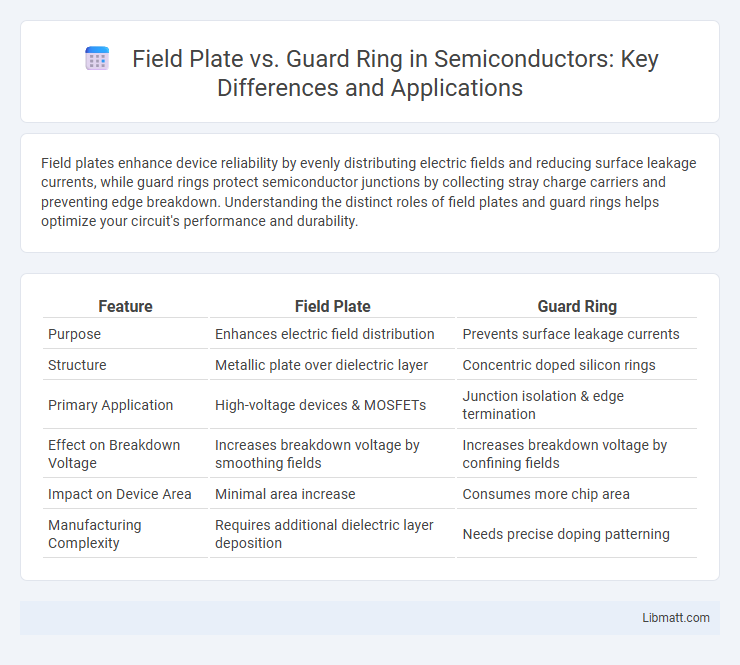Field plates enhance device reliability by evenly distributing electric fields and reducing surface leakage currents, while guard rings protect semiconductor junctions by collecting stray charge carriers and preventing edge breakdown. Understanding the distinct roles of field plates and guard rings helps optimize your circuit's performance and durability.
Table of Comparison
| Feature | Field Plate | Guard Ring |
|---|---|---|
| Purpose | Enhances electric field distribution | Prevents surface leakage currents |
| Structure | Metallic plate over dielectric layer | Concentric doped silicon rings |
| Primary Application | High-voltage devices & MOSFETs | Junction isolation & edge termination |
| Effect on Breakdown Voltage | Increases breakdown voltage by smoothing fields | Increases breakdown voltage by confining fields |
| Impact on Device Area | Minimal area increase | Consumes more chip area |
| Manufacturing Complexity | Requires additional dielectric layer deposition | Needs precise doping patterning |
Introduction to Field Plate and Guard Ring
Field plates and guard rings are critical components in semiconductor device design for enhancing voltage handling and controlling electric field distribution. A field plate is a conductive extension over the semiconductor surface that manages electric field crowding, improving breakdown voltage and reducing surface leakage currents. Guard rings, on the other hand, are implanted or diffused rings surrounding the active device area to isolate and stabilize electric fields, minimizing surface current leakage and preventing premature breakdown.
Importance in Semiconductor Devices
Field plates and guard rings play crucial roles in enhancing the reliability and performance of semiconductor devices by managing electric field distribution and preventing premature breakdown. Field plates optimize device stability by controlling surface charges and improving breakdown voltage, while guard rings provide effective edge termination to reduce leakage currents and enhance device isolation. Understanding their importance helps you design robust semiconductor components with higher efficiency and prolonged operational lifespan.
Structure and Design Differences
Field plates are metal layers placed over the passivation layer to modulate electric fields and reduce surface leakage currents, featuring a simple planar structure that extends the depletion region. Guard rings consist of doped semiconductor rings surrounding the active device area, designed to evenly distribute electric fields and prevent premature breakdown by isolating high-voltage regions. Your choice between field plate and guard ring implementations depends on specific device requirements for electric field control and fabrication complexity.
Working Principle of Field Plate
The working principle of a field plate involves controlling the electric field distribution within semiconductor devices by extending a conductive layer over the passivation region, which reduces surface electric field peaks and enhances breakdown voltage. Field plates effectively modulate the charge distribution at the device edges, mitigating premature edge breakdown and improving device reliability. Unlike guard rings that create physical depletion regions to spread the electric field, field plates use capacitive coupling to achieve smoother potential gradients.
Working Principle of Guard Ring
The working principle of a guard ring involves surrounding a sensitive semiconductor junction with a ring-shaped electrode that collects surface leakage currents and prevents them from reaching the active device region, thereby improving device isolation and reliability. Guard rings are typically biased to a fixed potential to create an electric field that repels unwanted charge carriers away from the main junction, reducing surface leakage and premature breakdown. This technique is critical in high-voltage devices and integrated circuits to enhance breakdown voltage and minimize leakage currents compared to the field plate approach.
Advantages of Field Plate
Field plates enhance device reliability by effectively reducing electric field crowding at critical junctions, which minimizes surface leakage current and improves breakdown voltage. Their integration allows for better control of edge termination in high-voltage semiconductor devices, leading to increased voltage handling and improved long-term stability. Your semiconductor design benefits from field plates through enhanced performance and reduced risk of premature device failure.
Advantages of Guard Ring
Guard rings provide enhanced electric field control by evenly distributing voltage stress around semiconductor devices, reducing the risk of premature breakdown. They improve device reliability and durability, especially in high-voltage and high-frequency applications, by minimizing surface leakage currents and parasitic capacitances. Guard rings also enable superior isolation between active regions, optimizing overall device performance and longevity.
Limitations and Challenges
Field plates often face limitations in high-voltage applications due to increased parasitic capacitance, which can degrade switching speeds and overall device efficiency. Guard rings pose challenges in scaling down device dimensions as they occupy significant chip area and may introduce complexity in layout design. Both structures demand precise fabrication control to ensure effective electric field modulation without compromising device reliability or performance.
Field Plate vs Guard Ring: Performance Comparison
Field plates enhance device reliability by distributing electric fields more evenly, reducing peak field intensity and improving breakdown voltage, while guard rings provide effective edge termination to prevent surface leakage currents and enhance isolation. Your choice between field plates and guard rings depends on the specific application needs, such as operating voltage, device architecture, and desired performance metrics like on-resistance and leakage current. Comparing both, field plates generally offer superior electric field management in high-voltage devices, whereas guard rings excel in controlling surface-related phenomena, leading to improved overall device stability.
Applications and Selection Guidelines
Field plates offer enhanced electric field management in high-voltage power devices, improving breakdown voltage and reducing surface leakage current, making them ideal for power MOSFETs and IGBTs in automotive and industrial applications. Guard rings provide effective isolation by surrounding active regions to prevent premature edge breakdown, commonly used in silicon-controlled rectifiers (SCRs) and diode array protection in integrated circuits. Selection depends on device voltage requirements, doping concentration, and manufacturing complexity, where field plates suit high-voltage, high-speed switching, and guard rings favor simpler, low-voltage protective designs.
Field Plate vs Guard Ring Infographic

 libmatt.com
libmatt.com